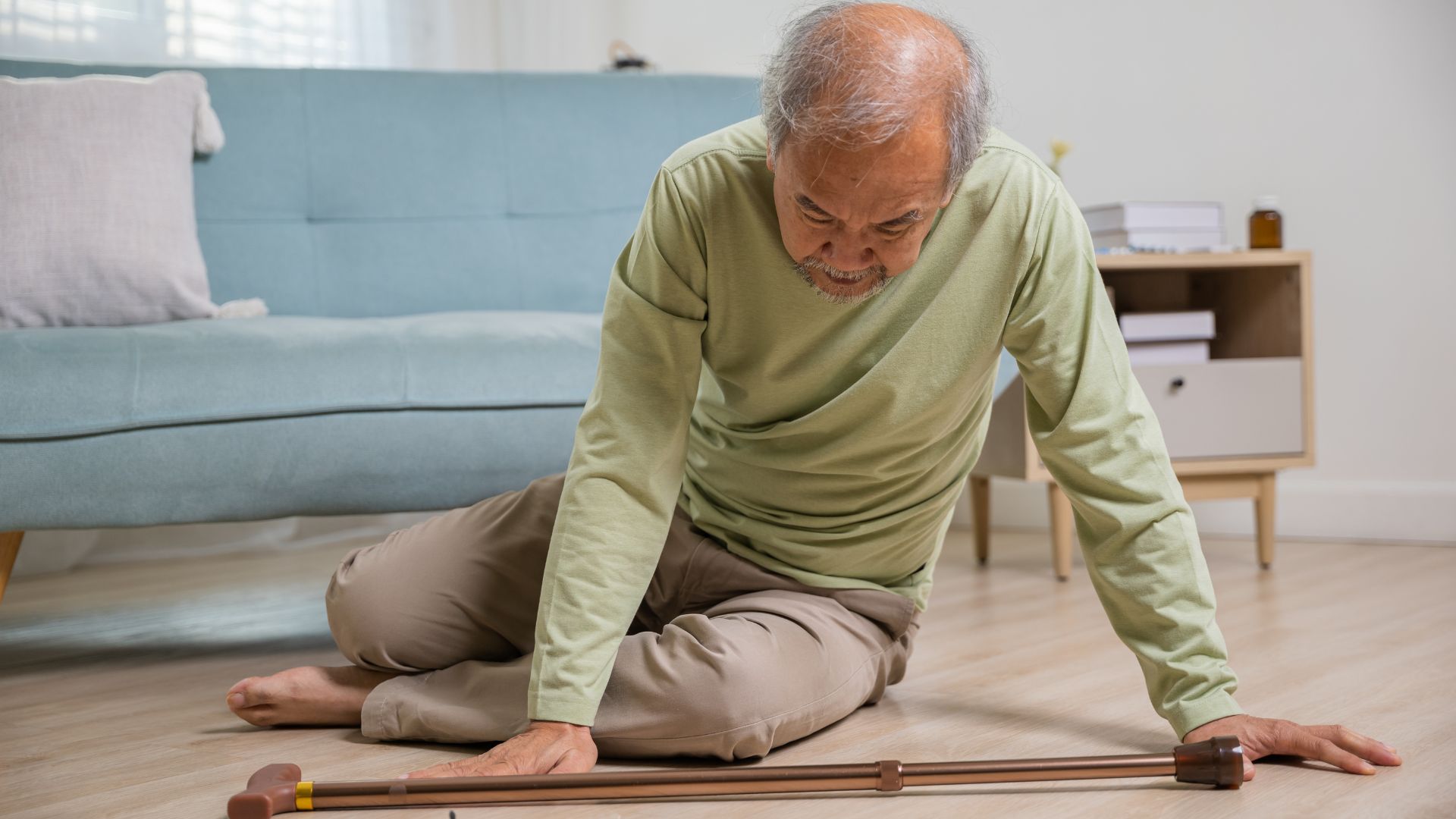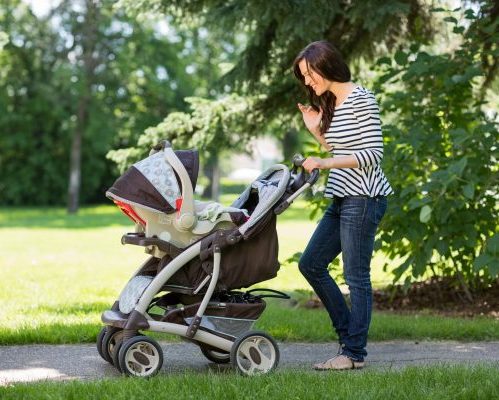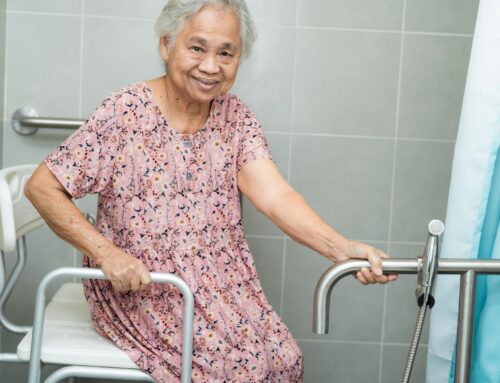Falls can happen to anyone – whether you’re recovering from an injury, living with a mobility condition, or simply navigating a slippery floor. In that moment, it’s easy to feel startled, scared, or unsure of your next move. The good news is that with the right strategies, you can learn how to get up safely and regain your confidence. At Propel Physiotherapy, our team helps clients practice these skills every day so they can feel confident, prepared, independent, and supported in their mobility.
This guide will walk you through a physiotherapy-informed approach to safely getting up from the floor after a fall – and how to practice the technique now, before you ever need it.
Table of Contents:
- Long-term Impact of Falls
- Why The Get-Up Technique Matters
- Safety Checklist Before Getting Up
- Step-by-Step Safe Get-Up Method
- Variations for Different Strength Levels
- Building Confidence & Fall Prevention Tips
- How Propel Physiotherapy Can Help
- Conclusion: How to Get Up From a Fall
Long-term Impact of Falls
Ever marvel at how often little children fall down and spring up instantly and keep playing like it didn’t even happen? For adults and even older children, falls aren’t just a momentary slip – they can trigger a cascade of consequences far beyond the initial impact.
The Physical & Emotional Impact
- After a fall, even if no obvious injury occurs, you may experience bruising, minor fractures, or soft-tissue damage. Left unchecked, these can lead to longer recovery, pain, and decreased mobility.
- From a psychological perspective, a fall often brings fear: fear of falling again, fear of losing independence, fear of going back to the floor and not being able to get up. That fear alone may cause people to limit their activity, creating a vicious cycle of reduced strength, poorer balance, and increased falls risk.
- According to the American Physical Therapy Association (APTA), patients who receive physical therapy within three months of a diagnosis or incident had significantly lower rates of falls up to a year later.i
- Falls also carry a major public-health and economic burden. The Centers for Disease Control and Prevention (CDC)’s STEADI initiative notes that falls affect more than one in four older adults annually, and can lead to hospitalization and long-term mobility loss.
Although many people associate falls with older adults, they can happen to anyone recovering from injury, with mobility or balance challenges, or simply navigating a moment of instability.
Why The Get-Up Technique Matters
Knowing how to get up after a fall is more than a contingency plan – it’s an empowerment tool. Practicing the technique helps you:
- Restore yourself to standing without relying solely on someone else.
- Reduce the time you spend on the floor, which lowers risks of pressure injuries, hypothermia, or worsening of minor injuries.
- Build awareness of your body’s movement capability, strength limitations, support needs, and environment hazards – all of which matter in fall prevention.
- Shift from a reactive mindset (“What happens if I fall?”) to a proactive mindset (“I can practice this, I’m prepared”).
At Propel Physiotherapy, we recognize that fall-risk and recovery aren’t just about the “older adult.” Whether you’re recovering from an injury, returning from surgery, navigating a neurological condition, or simply wanting to age with independence, understanding this skill is a meaningful part of the mobility toolkit.
Key Take-Away: It’s not only about avoiding the fall – it’s about what you do after. Practicing how to get up safely gives you confidence, reduces risk, and supports an active, independent lifestyle.
Safety Checklist Before Getting Up
Before attempting to get up after a fall, it’s important to pause, assess, and plan. Rushing into movement without first checking can increase the risk of further injury or complications. Use the following checklist to decide whether it’s safe to attempt standing – and when to seek help instead.
Step 1: Pause & Breathe
Take a moment. In the seconds after you fall you may be surprised, shaken, or disoriented.
- Sit or lie still for a moment.
- Take a few slow, deep breaths to let your heart rate settle.
- Focus on whether you feel steady enough to move.
This helps you avoid making a rushed movement that could cause more harm.ii
Step 2: Self-Check for Injury or Warning Signs
Ask yourself:
- Do I have sharp or increasing pain (especially in the head, neck, back, hips, or limbs)?
- Am I unable to move or do I feel numb/weak in any limb?
- Do I feel dizzy, lightheaded, or unwell?
- Is there visible bleeding, a wound, or a suspected fracture?
If yes to any of these, do not attempt to stand. Call for help, get assistance from a friend/caregiver, or contact emergency services if necessary.iii
Wearable technology solutions can help detect falls and connect you to emergency services that will come to your aid if needed.
Step 3: Scan Your Surroundings
If no major red-flags appear, check your environment:
- Is there a sturdy piece of furniture, a firm chair, a bed, or a wall nearby to help you rise?
- Is the floor clear of hazards (rugs, clutter, wet spots) that may interfere with your movement?
- Are you in a position where crawling or scooting toward a support is possible?
If yes, you’re better prepared for a safe transition.iv
Step 4: Decide to Move or Call for Assistance
- If you’re unsure, feel weak, dizzy, or don’t have a clear support piece nearby: Call for help.
Even if you think you could move, having someone nearby makes the process safer.ii
- If you feel able and the environment is supportive: proceed with the Step-by-Step Safe Get-Up Method (covered below!) and then return to Step 5.
Step 5: After You Are Upright
Once you’re standing:
- Hold onto the support (chair, wall) and stand still for 15-30 seconds.
- Shift your weight gently from side to side and forward and back to test your balance.
- If you feel steady, you may proceed to sit down and rest or gradually walk toward a safer spot.
- If you feel unsteady or weak, sit back down, call for help, and schedule a mobility review with your physiotherapist.
At Propel Physiotherapy, we support clients in safe movement transitions every day so, we emphasize that knowing when not to get up is just as important as knowing how. It’s a crucial part of your movement toolkit.
Step-by-Step Safe Get-Up Method
If you’ve assessed your situation and determined it’s safe to attempt getting up, follow these steps to do so safely. Remember, if at any point you feel unsure or experience pain, it’s crucial to stop and seek assistance.iii, iv
Step 1: Pause and Assess
Before moving, take a moment to:
- Check for injuries: Gently move your fingers and toes to ensure there’s no numbness or sharp pain.
- Breathe deeply: Calm yourself and prepare mentally for the movement ahead
- Plan your route: Identify a sturdy piece of furniture, like a chair or table, that you can use for support.
Step 2: Roll onto Your Side
- Bend your knees: Keep your feet flat on the floor.
- Turn your head: Look toward the direction you plan to roll.
- Use your arms: Push with your arms to roll your body onto your side.
Step 3: Transition to Hands and Knees
- Push up: Use your arms to push your upper body up, bringing your knees underneath you.
- Position your hands: Place them firmly on the floor for support.
Step 4: Crawl to Support
- Move carefully: Crawl toward the nearest sturdy piece of furniture.
- Use your knees: Keep them bent and close to the floor for stability.
Step 5: Rise to Standing
Once at the support:
- Place hands on the furniture: Position them shoulder-width apart.
- Lift your stronger leg: Bring it forward and place your foot flat on the floor.
- Push up: Using your arms and legs, rise into a half lunge-position.
- Stand up: From the lunge, push through your legs to stand fully.
If you cannot fully stand, sit on the furniture and rest. If standing is not possible, remain seated and call for help.
Variations for Different Strength Levels
Not all individuals have the same strength, mobility, or support needs – and that’s okay. The get-up technique can be adapted based on your current abilities or physical limitations. Practicing the version that fits you helps build confidence and keeps the movement safe and effective.
Variation A: For People with Knee Pain or Weak Lower Limbs
- Use a sturdy chair or piece of furniture that’s slightly higher than a standard seat to reduce the depth of movement.
- From side-sitting, crawl or scoot toward the chair instead of going all the way to hands and knees.
- Push up using the arms and stronger leg, and allow the weaker leg to assist or remain in a half-kneel.
- Follow up with strengthening exercises such as sit-to-stands and heel raises to build leg strength and stability.v
By reducing the range and relying more on a support surface, you decrease the risk while still practicing the movement.
Variation B: For Clients with Limited Shoulder/Arm Strength or Upper-Body Support
- Choose a support surface with height such that you can place your hands higher than floor level (eg. A sturdy table instead of a chair).
- From hands and knees, rather than pushing straight up from the floor with your hands, shift more of your weight into your legs and use the support surface primarily for balance.
- Work on upper body strength separately (eg. Wall push-ups) if upper limb strength is a limiting factor.
Variation C: For Assistive Device Users (Cane, Walker)
- Position the assistive device within reach before you begin the movement.
- Use the device as a stable “third hand” alongside your arms while you rise from half-kneel to standing.
- Once standing, ensure your device is set at the correct height and you feel steady before walking.
Variation D: For Clients Early After Surgery or With Neurological/Balance Challenges
- Perform the technique under supervision in the clinic first.
- Use a wall or parallel bars rather than unstable furniture.
- Stand and rest immediately if dizziness, blurred vision, or shaking are present – these may indicate you should not attempt to rise independently yet.
- Follow a graded progression: practice getting to side-sitting ® hands and knees ® half-kneel ® supported standing over multiple sessions.
Key Takeaway
Every version of the technique is valid as long as you can execute it safely and confidently. The goal isn’t speed – it’s competence and readiness. At Propel Physiotherapy, we encourage clients to practice the version that fits you now, and then build progressively toward more independence.
Building Confidence & Fall Prevention Tips
Practicing how to safely get up from a fall is only part of the picture. Building strength, stability, and confidence reduces the chances of falling again, and improves how quickly you recover if you do.
Here are some physiotherapy-informed strategies to help prevent future falls and support independence.
Strength & Balance Training
Improving lower-body strength, balance, and coordination directly reduces fall risk. Exercises such as sit-to-stands, calf raises, and single-leg balance (with appropriate support) can be practiced at home or in physiotherapy sessions.v
Medication Awareness
Some medications can cause dizziness, low blood pressure, or slower reaction times. If you notice changes after starting or adjusting a medication, speak with a healthcare provider to make sure it’s safe.vi
Optimize Your Home Environment
Simple changes can significantly reduce trip hazardsvii, for example:
- Removing loose rugs or clutter
- Adding night-lights or motion-activated lighting
- Installing grab bars in bathrooms
- Ensuring proper footwear with good tread
Practice Floor Recovery Skills Regularly
Confidence is built through repetition. Practicing safe transitions to/from the floor – under the guidance of a physiotherapist or PTA – helps make the movement feel natural and less stressful if a real fall occurs.
Know When to Ask for Help
If you cannot get up without significant pain or dizziness, call for assistance right away. Having a phone or medical alert system accessible at home can be an important part of a safety plan – especially for individuals with a history of falls.ii
Key Takeaway
With the right strategies and professional support, falls don’t have to be frightening – you can learn how to move safely, protect yourself, and feel confident in your ability to recover.
How Propel Physiotherapy Can Help
Every person’s mobility, strength, and health needs are unique. At Propel Physiotherapy, our rehabilitation team can help you:
- Learn and practice safe techniques for getting up from the floor based on your abilities
- Identify physical barriers like strength, balance, or confidence concerns that may increase fall riskvii
- Build a personalized exercise program to improve lower-body strength, balance, and endurancev
- Address home safety concerns through education about simple, meaningful environmental changes
- Prepare for real-world situations through functional training and practical practice in a safe setting
Falls can be frightening, but with guidance and regular practice, you can feel more in control of your body and your environment. Our goal is to help you stay active, independent, and confident.
Conclusion
Falls can happen to anyone, but being prepared can make all the difference. By learning how to get up safely, practicing the technique that works best for you, and building strength and confidence over time, you can reduce fear and maintain independence. If you’re unsure where to start or want personalized guidance, our team at Propel Physiotherapy is here to help you move safely and confidently in your daily life.
References
[i] American Physical Therapy Association. Balance and Falls. Apta.org. Published 2024. Accessed October 27, 2025.
[ii] National Council on Aging. Practicing Getting Up from and Down to the Floor to Reduce Falls Risk. Ncoa.org. Published June 18, 2025. Accessed October 27, 2025.
[iii] Philips Lifeline. How to Get up from a Fall. Accessed October 27, 2025.
[iv] Colino S. The Safest Way for Older Adults to Get Up From a Fall. AARP. Published December 19, 2023. Accessed October 27, 2025.
[v] John Hopkins Medicine. Fall Prevention: Balance and Strength Exercises for Older Adults. Hopkinsmedicine.org. Published June 20, 2024.
[vi] CDC. Facts About Falls. Older Adult Fall Prevention. Published June 10, 2024. Accessed October 28, 2025.
[vii] NIH: National Institute on Aging. Falls and Fractures in Older Adults: Causes and Prevention. National Institute on Aging. Published September 12, 2022. Accessed October 28, 2025.
Written by










